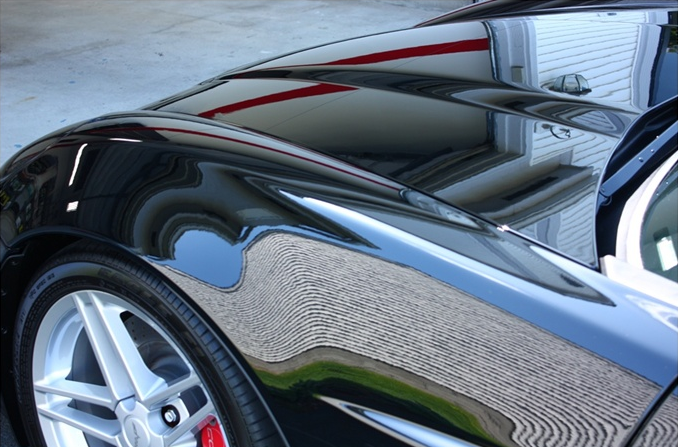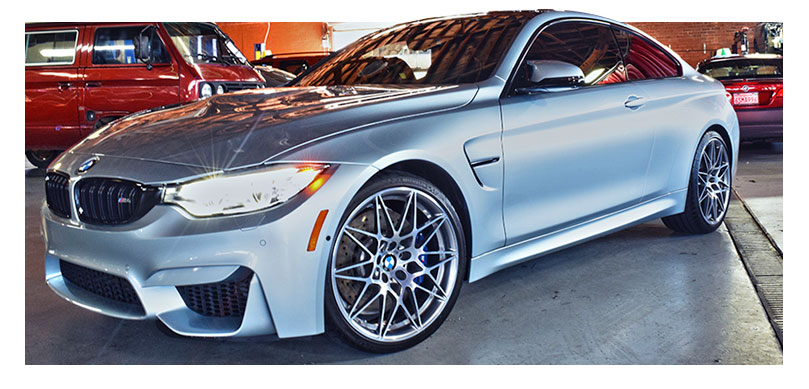Claying a Vehicle
Every vehicle shares a common enemy. It relentlessly pursues the car from the second it leaves the factory until it meets its ultimate demise. The enemy is pollution. It’s the air we breathe, it’s on the roads we drive, and it attaches to your vehicle’s paint, where it bonds and begins a process of oxidation.
When contaminates get a solid grip on your vehicle’s paint, washing alone is not enough to remove them. Also, pre-wax cleaners may not be able to exfoliate large particles. In this case, you have two choices: use a polish or heavy cleaner, which removes a lot of paint material, or use a clay bar. Clay is not a polish or a compound. Clay is a surface preparation bar that smoothes the paint and exfoliates contaminants.
One of the many reasons for using clay is the removal of brake dust. Brake dust contamination, which attaches to painted rear bumpers and adjoining surfaces, is a metallic surface contaminant that can be safely and effectively removed using clay. Tree sap and tar specks can also be safely removed with a clay bar. Likewise, clay is an effective paint over-spray. If the over-spray is particularly heavy, you may want to seek the assistance of a professional.
How do you know if you need to use a clay bar? After thoroughly hand washing your car, feel the surface. Do you feel bumps and rough spots? These bumps are contaminates attacking the finish. Removing the surface contaminates (road tar, acid rain spots, bug residue, paint over-spray, brake pad dust, hard water spots, etc.) will improve both the look and health of your vehicle’s paint. By the way, you can magnify your sense of touch by inserting your fingertips into a thin sandwich bag or a piece of cellophane.
No matter how well you hand-washed your car, many of the particles that have worked their way into the paint finish will remain. Have you ever looked at your foam wax applicator pad after applying a coat of wax? What do you think that black stuff is? Its dirt and you are waxing over it, sealing it in!
Clay itself isn’t new. In fact, it’s one of the most common compounds on earth. However, it’s fairly new to the car detailing market. Clay bars are made of fine clay particles in a soft, malleable clay medium that allows the bar to be formed and kneaded. Some clay markers add color to make the bar more attractive or to identify bars of differing strength. Synthetic clay bars are also becoming available. The synthetic bars improve on the natural clay product in both performance and durability.
Many clay products claim to contain no abrasives. This is stretching the truth. The reason most clay manufactures claim they don’t contain abrasives is because the general public thinks the word abrasive refers only to aggressive, paint removing materials. The fact is the abrasives in most automotive clay products are so fine that you will not see any reduction in paint gloss. After several uses, paint luster may even improve.
Before using a clay bar on your vehicle, you must thoroughly clean and dry it to remove any loose dirt. Direct sunlight should not fall on your car’s surface and its best if the work area is relatively cool to prevent rapid evaporation of the clay lubricant.
To use the clay bar, you spray a water-based lubricant on a small area of your vehicle and rub the bar back and forth with light to medium pressure. If the lubricant begins to dry, you will need to spray more. Clay bars are fairly sticky, and cannot be used dry. Try using it dry and you will make a mess.
After a few passes with the clay bar, rub your hand over the area to feel if the surface contamination was removed. Keep rubbing until all contamination bumps are gone. Finally, wipe the clay residue off with a soft terry cloth towel. Just like waxing, work in small areas.
Check the clay bar frequently for hard particles. When found, pick them off. Make it a habit to occasionally knead and reform the bar so that a fresh portion of the bar contacts your vehicle’s paint. If you drop your bar of clay on the ground, its history, toss it out. Do not take a chance. Discard the clay bar if it becomes impregnated with grit.
When you’re finished claying your vehicle, you should go over it with a pre-wax cleaner to finish your newly cleaned finish with one or more coats of rich Carnauba wax.
Clay products offer many advantages in the removal of surface contamination from paint. First, even in the hands of a lay person, it is difficult to do any damage to your paint with clay. Sure, if you use a dirty clay bar, scratches may result. However, compared to machine buffing, polishing or sanding clay is much safer.







Leave A Comment